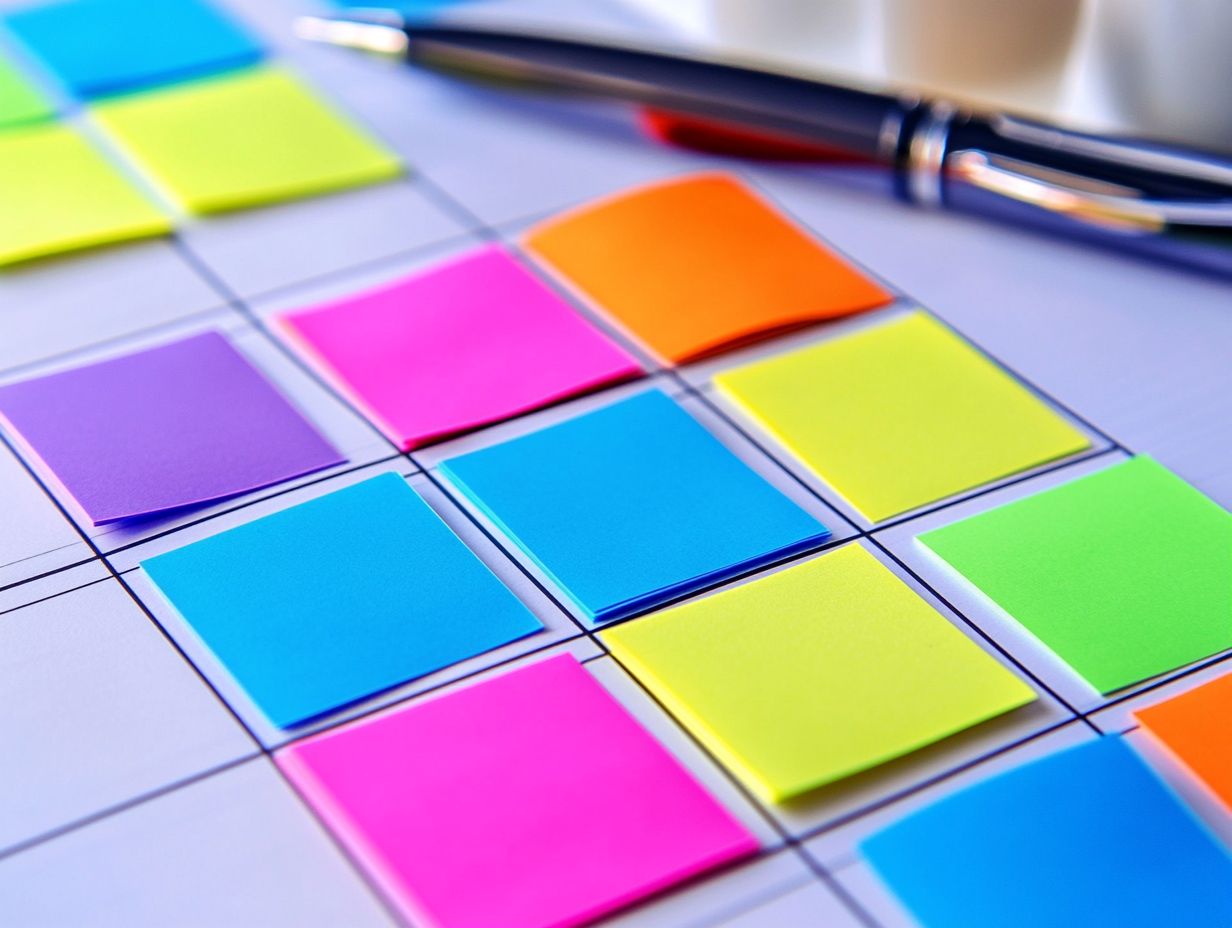“Color-Coding Your To-Do List: Tips and Tricks”
A cluttered to-do list can often seem daunting. However, color-coding presents a vibrant solution that not only organizes your tasks but also elevates your productivity!
This article delves into the numerous benefits of color-coding your to-do list. It highlights how it can streamline your daily routines and offers specific strategies for effective implementation.
Get ready to learn how to pick the perfect color scheme, assign colors to various categories, and leverage visual signals for enhanced time management. Immerse yourself in this transformative approach to task management!
Contents
- Key Takeaways:
- The Benefits of Color-Coding Your To-Do List
- How to Color-Code Your To-Do List
- Tips for Effective Color-Coding
- Tricks for Making the Most of Your Color-Coded To-Do List
- Frequently Asked Questions
- What are the benefits of color-coding your to-do list?
- How do I choose which colors to use for my to-do list?
- Is there a specific system or method for color-coding a to-do list?
- Can I use the same color-coding system for both personal and work-related tasks?
- Are there any tips for maintaining a color-coded to-do list?
- Why should I consider color-coding my digital to-do list?
Key Takeaways:

- Organize your to-do list by color-coding to improve efficiency and productivity.
- Choose a color scheme and assign colors to categories for easy visual recognition.
- Maximize the benefits of color-coding by using it as a reminder system and integrating it with time management techniques.
The Benefits of Color-Coding Your To-Do List
Color-coding your to-do list revolutionizes mundane task management. It turns it into an engaging and efficient experience!
This method is very helpful for planning schoolwork and enhances your workflow by providing visual signals that streamline your daily planner.
Not only does it elevate task visibility, but it also helps you categorize tasks making it easier to distinguish between urgent, important, and less critical activities.
This structured method is very helpful for meal prep and various commitments. By incorporating color-coding tools and techniques, you tap into the psychological advantages of color strategy, ultimately leading to a significant boost in your productivity.
Organizational Advantages
The organizational advantages of color coding are truly remarkable. It allows you to categorize tasks with precision based on their importance or urgency.
This not only enhances your overall task management strategy but also elevates your productivity! For instance, in an academic setting, if you assign specific colors to different subjects like blue for Biology and green for English you’ll find it much easier to prioritize assignments and study sessions at a glance.
This visual differentiation gives you the power to allocate your time more effectively while reducing the mental clutter that often accompanies juggling multiple commitments!
The benefits extend beyond academics. Regarding meal planning, particularly for individuals managing GERD dietary restrictions, color coding can simplify the entire process.
By highlighting GERD-friendly foods in green and marking those to avoid in red, you transform meal prep into an organized endeavor. This clarity in dietary choices eliminates second-guessing!
Increased Productivity and Efficiency
Implementing a color-coded system in your planning efforts can significantly boost your productivity and efficiency. It streamlines the process of distinguishing between urgent tasks and those that are important but not pressing.
By assigning different colors to various categories such as assignments, personal commitments, and deadlines you can enjoy a clearer perspective when reviewing your planner!
This creative approach not only serves as a helpful reminder for tasks but also allows for personal expression, transforming the planning process into something more engaging.
Students, in particular, will find that these vibrant hues can turn intimidating schedules into visually appealing guides. This enhances both academic management and personal organization!
This method gives you the power to blend creativity with structure, making task completion a more enjoyable experience that positively influences your daily life.
How to Color-Code Your To-Do List
Crafting an effective color-coded to-do list demands a discerning approach to selecting your color scheme. Thoughtfully assigning colors to specific categories provides immediate visual signals that streamline your task execution and enhance productivity!
Choosing Your Color Scheme

Choosing your color scheme is a crucial first step in creating an effective color-coded system. Different colors evoke a range of emotional responses, and you can harness this to boost your motivation to complete your tasks.
For example, warm tones like red and orange can ignite energy and urgency, making them perfect for high-priority tasks or looming deadlines. In contrast, soothing blues and greens promote focus and tranquility, which are ideal for activities that demand deep concentration.
Incorporating planner supplies such as highlighters, colored pens, or sticky notes will make your workspace pop with color! By thoughtfully assigning colors to specific task categories, you can streamline your workflow, making it not just efficient but genuinely enjoyable.
Assigning Colors to Categories
Assigning colors to categories like “urgent” and “important” elevates task visibility and prioritization. This ensures that critical tasks stand out at a glance.
By integrating a color-coding system, you can streamline your workflow with finesse. For instance, use bright red for urgent tasks, and soft yellow for important yet less pressing assignments. A soothing green can represent completed tasks, instilling a gratifying sense of accomplishment.
This approach helps you recognize tasks quickly and enhances your overall management by providing a consistent visual cue across various platforms and tools.
Consistently adhering to this color scheme cultivates familiarity, making it easier for team members to collaborate seamlessly and stay aligned on priorities.
Tips for Effective Color-Coding
To truly maximize the effectiveness of your color-coded to-do list, it s vital to embrace strategic techniques that elevate both your reminder system and time management skills.
Using Color-Coding as a Reminder System
Utilizing color coding as a reminder system involves strategically placing sticky notes or planner stickers that correspond to specific tasks. This elevates your planner organization to new heights.
This technique can redefine how you manage academic deadlines or social engagements, all while adding a visually appealing touch. For instance, you might designate red for urgent assignments think paper due dates and looming exams while blue could represent club meetings or social events. By assigning distinct colors to each type of task, you can effortlessly glance at your planner and immediately identify your priorities.
Incorporating washi tape, a decorative tape used for crafting and organizing, in various hues infuses creative flair into your planner. This transforms the system into something both functional and aesthetically pleasing. Not only does this boost your motivation, but it also enhances your productivity, making planning a far more enjoyable experience.
Utilizing Color-Coding for Time Management
Leveraging color coding for time management can profoundly enhance your ability to allocate time efficiently across various task categories. This ensures that your critical planner goals are consistently met.
By incorporating different colors into your daily or weekly planner, you can effortlessly categorize tasks based on urgency and importance. For instance, using a vibrant red highlighter for deadlines that demand immediate attention instantly captures your focus, while a soothing blue may signify tasks that hold importance but allow for some flexibility in timing.
Utilizing stickers in shades of green for long-term projects enables you to visualize progress over time. This method boosts clarity and transforms your planning experience into an enjoyable and interactive process, making it all the more rewarding.
Tricks for Making the Most of Your Color-Coded To-Do List

Try these clever tricks to turn your color-coded to-do list into a functional masterpiece that is also visually captivating.
This enhancement will significantly enrich your overall task management experience, making it both efficient and enjoyable.
Don’t let your tasks slip away color-code them for instant visibility! Get started today and watch your productivity soar!
Incorporating Visual Cues
Incorporating visual cues into your color-coded system can dramatically elevate your planner organization. It makes it effortless to identify and prioritize tasks at a glance.
By integrating icons or symbols alongside your color schemes, you create a more intuitive system tailored to your specific needs. For example, a green tick mark for completed tasks instantly signals success, while a red exclamation mark highlights urgent priorities.
Adding visual elements like mini calendars for deadlines or stars for high-priority items further clarifies each task’s status. This differentiation helps you process information quickly and encourages deeper engagement with your planning, ultimately boosting productivity and alleviating feelings of overwhelm.
Creating a Color-Coded Key
Creating a color-coded key is vital for solidifying your color coding system. It ensures that each color distinctly represents a specific task category for maximum clarity and ease of use.
This organization method enhances visual appeal and simplifies tracking multiple tasks at a glance. To effectively design your color-coded key, consider using a planner or bullet journal, which are structured tools perfect for implementing this system.
For supplies, consider these options:
- Highlighters for vibrant distinctions.
- Colored gel pens for easy tracking.
- Washi tape to mark important tasks.
- Sticky notes for quick reminders.
By incorporating these supplies thoughtfully, maintaining the key becomes a seamless and enjoyable part of your planning routine.
Frequently Asked Questions
What are the benefits of color-coding your to-do list?
Color-coding your to-do list boosts your productivity and keeps you on track!
How do I choose which colors to use for my to-do list?

Choose colors based on your personal preferences and what each color represents to you. For example, you may associate red with urgent tasks and green with less important ones.
Is there a specific system or method for color-coding a to-do list?
There is no right or wrong way to color-code a to-do list. You can create your own system or use pre-made color-coding templates available online.
Yes, you can use the same color-coding system for all areas of your life. This can make it easier to manage your tasks and see how your different responsibilities relate to each other.
Are there any tips for maintaining a color-coded to-do list?
Consistently use the same colors for the same types of tasks to avoid confusion. Regularly review and update your color-coding system as needed.
Why should I consider color-coding my digital to-do list?
Color-coding can also be applied to digital to-do lists, making it easier to categorize and organize tasks on your electronic devices. This is especially helpful for people with busy schedules or multiple responsibilities.
Don’t wait start organizing now!






